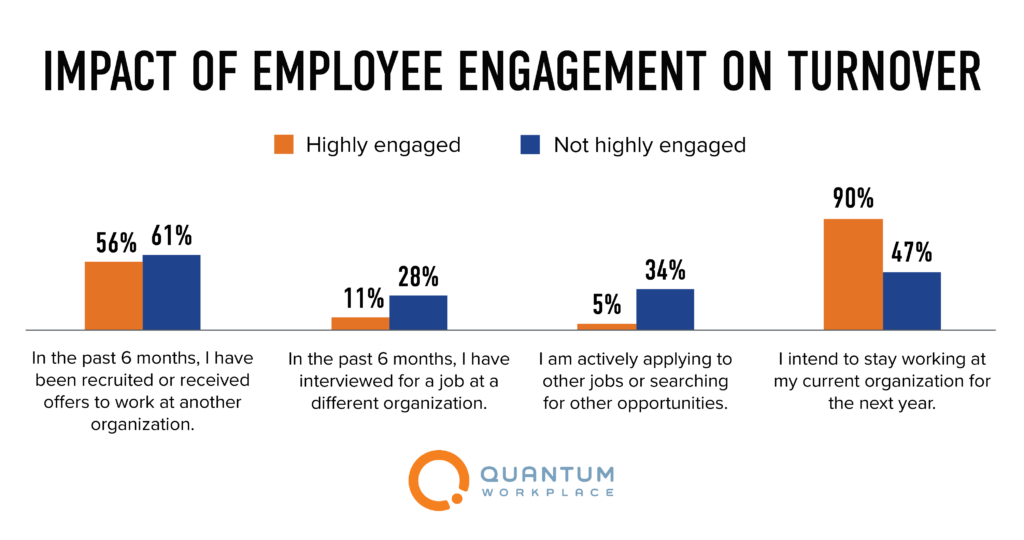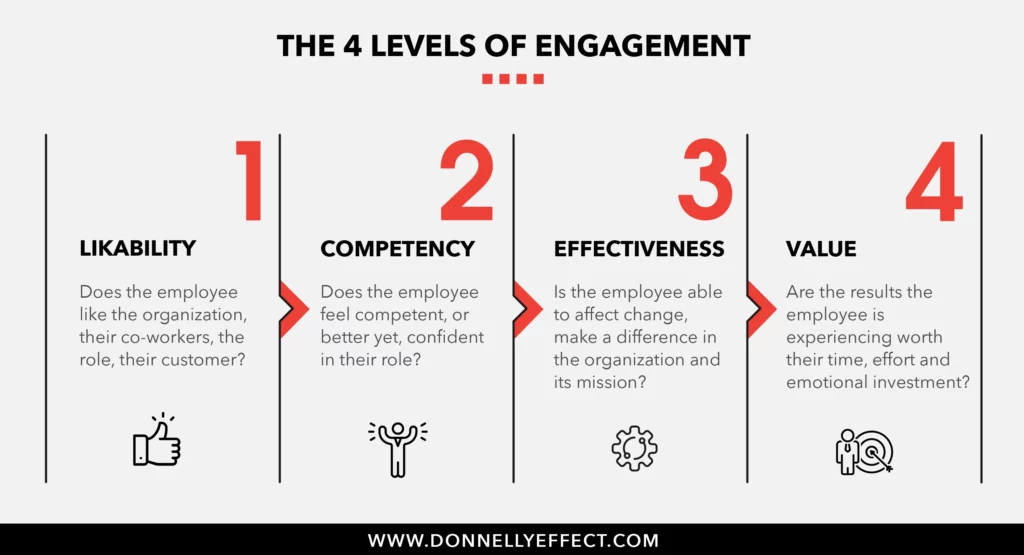As manufacturing businesses continue to recover from the impact of a global pandemic, they face myriad challenges. Now more than ever, employee engagement is important for manufacturers.
Today’s industrial businesses are experiencing obstacles like inflated fuel and material prices, supply chain disruptions, and a significant labor shortage. At the start of this year, America had 11.3 million positions available with no workers to fill them. At a time when so many external factors are working against them, manufacturing companies can strengthen their business and continue to thrive by focusing inward. Creating an environment where workers are actively contributing to the success of the business is essential for generating leads and bringing in revenue.
Keep reading to learn why employee engagement is important for manufacturers and how to improve overall participation.
Key Takeaways
- Engaged employees are actively involved in what’s happening in their company and are committed to helping everyone reach their goals.
- From saving the company money to reducing absenteeism, there are several reasons why employee engagement is important for manufacturers.
- Seek input, assess results, and communicate an action plan to boost employee engagement.
5 Reasons Why Employee Engagement Is Important for Manufacturers
Employee engagement is when workers are involved in what’s happening with their company and their team and play an active role in helping everyone reach their goals. They’re committed to their duties and enthusiastic about contributing to the success of the group. Here are five reasons why that’s beneficial to your company and why employee engagement is important for manufacturers.
1. Saves Money
Today, only 36% of employees are engaged at work. This means the majority of workers aren’t invested in their roles. They exert little effort, fail to follow up with customers, and don’t particularly care whether the company succeeds or not. This leads to a decrease in productivity, loss in production, and unhappy customers. A lack of attention to detail results in low-quality products and services, resulting in missed sales. Engaging employees helps increase their commitment, grows their desire to contribute to success, and helps to avoid missed business opportunities.
2. Fewer Mistakes
From purchasing machinery to working on an assembly line, some duties in the manufacturing industry are highly repetitive and often monotonous. Employees who aren’t invested in their roles or in the success of the company could absentmindedly make costly (and sometimes dangerous) mistakes. These could lose the company money, possibly result in injuries, and damage the business’s reputation. When employees care about their role, they pay closer attention to their work, put forth more effort, and make fewer mistakes.
3. Reduces Absenteeism
Engaged employees are more dedicated to their jobs because they feel a sense of worth and importance in the work they do. They don’t want to let down their team or company, so they consistently show up to work. Teammates and business leaders know they can count on these individuals to be on time and effective in their roles. This helps keep projects moving through the pipeline and money flowing to the company.
4. Strengthens Teamwork
When employees know they can count on each other to be on time, fully present, and proactive in working together toward a common goal, it builds a strong sense of teamwork. Teamwork leads to collaboration, innovation, and a positive work environment. When people feel valued and supported, they contribute more and increase productivity, further propelling the company toward successfully achieving its goals.
5. Retains Top Talent
When people feel their contributions provide value to the company and work in a positive environment where their ideas are encouraged and supported, they’re more inclined to stay with the company. They feel connected to their team and their leaders and even become brand ambassadors. This reduces turnover and helps businesses retain top talent, strengthening their team and achieving overall success.

3 Steps to Boost Employee Engagement in Manufacturing
To build a strong, dedicated team that proactively seeks to propel your business toward its ultimate goals, you must prioritize employee engagement in manufacturing. Follow these three steps to assess the culture and climate of your company, discover ways to boost employee engagement, and create a plan that encourages worker involvement and contribution.
Step 1: Ask for Feedback
You can measure employee engagement on four levels:
- Likability
- Competency
- Effectiveness
- Value

The best way to understand how your employees feel – about their role, team, leaders, and the company overall – is to ask. Reach out to your workers with specific questions to learn how their experience is perceived. Candid input can provide invaluable information about areas where engagement is low and can reveal why staff involvement is lacking.
Whether you use surveys or hold one-on-one conversations with your employees, listening to their concerns and frustrations can reveal opportunities for improvement. You’ll learn what’s important to your workers and what can you can do to earn their participation and involvement.
Step 2: Review Insights
Once you’ve gathered candid feedback from your staff, you must review the findings. This data can reveal invaluable information, like:
- Dissonance with leadership approach
- Breakdown in communication
- Need for appreciation
- Origins of morale issues
You might discover patterns that indicate an engagement issue isn’t an isolated problem with a particular employee but rather a management or process issue. Realizing these things can help you improve and streamline your manufacturing business so that people feel more valued, empowered, and inclined to engage with their role and the company at large.
Step 3: Communicate and Act
Once you’ve identified problems within your organization, you can begin to develop a solution that increases engagement and boosts productivity. With a plan in place, you can decide what you’ll communicate to your workers and how to frame that message for a positive perception that motivates and encourages people to become more involved.
Highlight trends, patterns, and interesting observations you found in the feedback. Point out actionable items and explain your next steps toward a solution. Transparency lets people know what to expect, builds trust, and encourages engagement as workers realize they have your support.
The following video provides best practices for sharing the results from your employee engagement surveys:
Video Source: DecisionWise on YouTube
Increase Employee Engagement within Your Company
Shanahan Strategy is an experienced agency that helps with marketing for manufacturers. We follow marketing trends for manufacturing companies so we can help build a strategic digital marketing strategy that helps build awareness, boost conversions, and deliver useful insights. From SEO basics for manufacturing and industrial companies to content marketing for manufacturing companies, our services help in driving website traffic for manufacturing companies and generate more revenue.
Contact Shanahan Strategy today to learn how we can help you increase employee engagement and reach your marketing goals.

